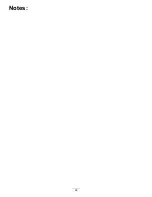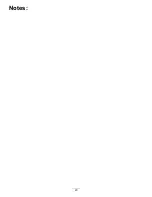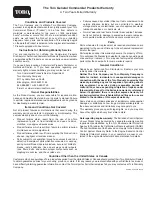
Cutting Unit Characteristics
The dual knob bedknife-to-reel adjustment system
incorporated in this cutting unit simplifies the
adjustment procedure needed to deliver optimum
mowing performance. The precise adjustment
possible with the dual knob/bedbar design gives the
necessary control to provide a continual self-sharpening
action-thus maintaining sharp cutting edges, ensuring
good quality-of-cut, and greatly reducing the need for
routine back lapping.
Daily Adjustments of Cutting Unit
Prior to mowing each day, or as required, each cutting
unit must be checked to verify proper bedknife-to-reel
contact.
This must be performed even though
quality of cut is acceptable.
1. Lower the cutting units onto a hard surface, shut off
the engine, and remove the ignition key.
2. Slowly rotate the reel in a reverse direction,
listening for reel-to-bedknife contact. If no contact
is evident, turn the bedknife adjusting knobs
clockwise, one click at a time, until light contact is
felt and heard.
Note:
The adjustment knobs have detents
corresponding to 0.0009 in. (0.023 mm) bedknife
movement for each indexed position.
3. If excessive contact is felt, turn the bedknife
adjusting knobs counterclockwise, one click at
a time until no contact is evident. Then turn
the bedknife adjusting knobs one click at a time
clockwise, until light contact is felt and heard.
Important:
Light contact is preferred at all
times. If light contact is not maintained,
the bedknife/reel edges will not sufficiently
self-sharpen and dull cutting edges will result
after a period of operation. If excessive contact
is maintained, bedknife/reel wear will be
accelerated, uneven wear can result, and quality
of cut may be adversely affected.
Note:
As the reel blades continue to run against
the bedknife, a slight burr will appear on the front
cutting edge surface along the full length of the
bedknife. If a file is occasionally run across the
front edge to remove this burr, improved cutting
can be obtained.
After extended running, a ridge will eventually
develop at both ends of the bedknife. These notches
must be rounded off or filed flush with the cutting
edge of the bedknife to ensure smooth operation.
Note:
Over time, the chamfer (Figure 25) will need
to be reground as it is only designed to last 40%
of the bedknife life.
Figure 25
1.
Lead-in chamfer on right end of bedknife
Note:
Do not make lead-in chamfer too large as
it may cause turf tufting.
Servicing Bedknife
The bedknife service limits are listed in the following
charts.
Important:
Operating the cutting unit with the
bedknife below the “service limit” may result in
poor after-cut appearance and reduce the structural
integrity of the bedknife for impacts.
Bedknife Service Limit Chart
Bedknife
Part No.
Bedknife Lip
Height *
Service Limit
*
Low HOC
(Optional)
110-4084
.220
.190"
EdgeMax®
(Production)
108-9095
.270
.190"
Standard
(Optional)
108-9096
.270
.190"
Heavy Duty
(Optional)
110-4074
.370
.190"
16









































